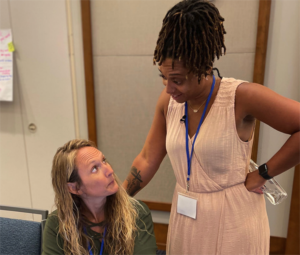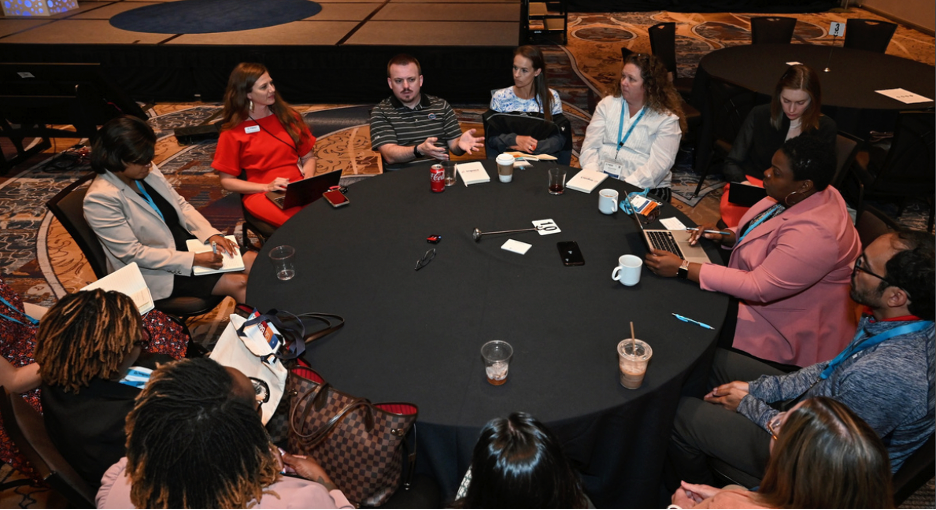
There are many reasons we love Impact Florida’s Solving with Students Cadre. As a pilot partner, we are learning so much through this innovative professional learning model based on student feedback for Florida math teachers. And it’s not just us. Ninety-eight percent of teachers in the first pilot reported making substantive changes to their practice. What’s most exciting is what we are hearing from learners. Students of participating teachers confirmed the changes their teachers are making are having real impact on their experiences in the classroom.
Solving with Students is an initiative of Impact Florida designed to use student feedback on classroom learning conditions from the PERTS: Elevate survey as a lever for developing teacher practice. The first pilot included 49 secondary math teachers with anywhere from zero to more than 21 years of experience representing 16 districts across the state who applied to participate. Impact Florida supported teachers in the cadre to implement the survey with students in their classrooms, analyze the results, and then test small changes in practice in iterative cycles based on ongoing feedback through follow-up surveys.
Throughout the experience, Impact Florida regularly brought the cadre together for targeted support, to share problems of practice, and to build community. Teachers also had the option to receive six additional hours of formal one-on-one virtual coaching from an NTC program consultant or informal coaching through regular check-in calls with Impact Florida’s cadre leader.
The PERTS: Elevate survey asks students to provide anonymous feedback on learning conditions in their classrooms.
One reason we are so enthusiastic about the project is it incorporates key design features that matter according to the research on what works in professional learning. These features, which also guide our approach at NTC, provide a solid jumping-off point for innovation and include:
- priority emphasis on building relationships
- well-planned opportunities for teacher collaboration
- one-on-one coaching with follow-up
- focus on subject-specific instructional practice vs. content knowledge
Another reason is the richness of the data. NTC’s impact team evaluated survey results from the first pilot and gathered insights from coaching conversations as well as teacher and student focus groups. Participants authentically shared stories of their hopes, fears, challenges, discoveries, and the important lessons captured in the nuances of what students had to say. Taken together, the findings from the pilot cadre were compelling. Not only did we see almost immediate student-reported improvements in participating teachers’ classrooms, we saw how teachers’ mindsets shifted as they engaged, with peer and coach support, in increasingly deeper ways with the feedback from their students.
We are also encouraged by the nature of teacher commitment we saw. Even after so much hardship and disruption over the past several years, cadre teachers — the majority of whom were long-term veterans with 10, 15, 20+ years of experience — jumped at this opportunity to grow professionally. They weren’t “voluntold” to participate, and the small stipend notwithstanding, they applied because they were genuinely interested in analyzing their practice from their students’ perspective to make positive changes. That willingness to be vulnerable, in and of itself, had a powerful influence on the classroom relationship, according to both teachers and students.
NTC senior program consultant and former math teacher Tiana Pitts, who coached about half the teachers in the pilot cadre, concurred. “It’s important to consider what teachers were messaging to their students by participating. They were essentially saying to them: ‘I want to grow. I want to learn. And I need you to help me,’” Tiana said. The surveys then allowed students to anonymously share their true opinions — if they thought their teachers cared about them, how the classroom community felt, if the work they were asked to do was meaningful. Using this data, teachers then chose an area to focus on, validating students’ feedback and, in most cases, bringing them into partnership to identify and test new strategies.
“It’s important to consider what teachers were messaging to their students by participating. They were essentially saying to them: ‘I want to grow, I want to learn. And I need you to help me.’”
Following each cycle of survey feedback, teachers were asked to report the extent to which they interacted with students about their focus area and strategy for addressing results. In general, teachers who intentionally engaged students in conversations about changes they were making saw more improvement in learning conditions. When teachers did not engage students in inquiry cycle conversations, the percentage of students providing positive feedback generally declined or remained flat.
Research suggests that efforts to promote student voice in the classroom can influence student engagement in learning. We believe Solving with Students reflects that potential in alignment with NTC’s guiding belief that meaningful teaching and learning is a partnership — a reciprocal, relational, human interaction between teachers and students that nurtures the potential of each individual in a community of learners.
The value-add of coaching — Teacher well-being and accelerated growth
To learn more about how coaching can both deepen and extend the impact potential of student data on teacher practice, we talked with Tiana about what she did and what she learned in her close collaboration with participating teachers. All of her coaching moves, she said, were designed to create safe spaces of optimal learning for teachers.
Of the teachers who received formal coaching, 81% strongly agreed they had made permanent and substantive changes to their practice.
Establishing the relationship

NTC’s Tiana Pitts (right) working with Impact Florida
For those teachers who opted in, Tiana provided six hours of remote one-on-one coaching from February to June, focusing on four cycles of student surveys from the teacher’s classroom.
In her first interactions with teachers, Tiana said her priority was to create connections. “They don’t know me. We’re meeting virtually. I’m in North Carolina. They’re in Florida. So, it was critical for me to establish that relationship from day one, set a really solid foundation, to build that rapport and trust in order to have some tough conversations later. That first coaching session, I said, ‘we’re not looking at data; we’re talking to each other. Let’s talk about how your life is; let’s talk about how things are going.’ I asked them to tell me about their journey in education. ‘Where did you start? What made you decide to teach? Why are you still teaching? Why are you teaching at the school where you are now? Why did you choose this particular professional development opportunity? What are you looking for out of this experience?’ I also told them a little bit about myself, my background, that I was a math teacher, and I understood where they were coming from.”
“They don’t know me. We’re meeting virtually. I’m in North Carolina. They’re in Florida. So, it was critical for me to establish that relationship from day one, set a really solid foundation, to build that rapport and trust in order to have some tough conversations later.”
Taking a deep look at student feedback
The next thing Tiana did was ask each teacher to re-engage with the student data, understanding the competing priorities teachers are continuously juggling. I said to them: “I know that you probably have looked at your data, but you probably had interruptions because it was your planning period or you looked at it real quick after hours at home, so I want to take some of our time together to look at it with fresh eyes.’ We spent a good 10 minutes looking at it independently; my camera is off, their camera is off, to really ground us in the data before we talked about it.”
Spending that time to look at the student feedback in more than a cursory way, and in the context of having an immediate and immersive conversation about what the data meant and what to do about it, was what made the difference. One focus group teacher said: “I look through the survey, and I’m like, ‘Oh, oh, okay. I don’t know how I’m going to fix that.’ And then you have that hour with Tiana, and she’s like, ‘Well, wait a minute. It’s not really that bad … let’s work on this.’ She pointed out things that I would never have taken the time to look at, and it helped me tremendously.”
Spending that time to look at the student feedback in more than a cursory way, and in the context of having an immediate and immersive conversation about what the data meant and what to do about it, was what made the difference.
Starting with what’s working — Assets, not deficits
Another key step was to focus on what’s working. Tiana said she had to push teachers not to overlook data that indicated where they were already having positive impacts on the learning environment. “They’re math teachers; they want to solve problems. They’re going to go to the problems first. That’s just how our brains work. As a coach, I have to help them prioritize looking for the things that are going well. I have to push them. It’s part of building the rapport, but there’s also a lot of meaningful data there that they shouldn’t overlook. For example, if your results for ‘meaningful work’ are at 80%, that’s a good thing. Of course, we have to look at that 20%, but let’s start with the 80% —‘What do you think you’ve done to create that kind of environment for your students?’ That’s hard for them, first to stop and name what’s going well but also to identify what behaviors or actions might account for that, and that’s really important to know.”
Starting with what the teacher was doing right proved very meaningful for participants. It also modeled a critical stance of asset-based, learner-centered teaching. “I had a couple of teachers start crying. You can go into it with a deficit mindset of all the things you’re not doing right. Me reminding them of the things that are going well is good for their spirit. I had one teacher say, ‘thank you for pushing me to see that because I thought I was failing my kids.’ They’re hard on themselves, some of them are really hard on themselves, and I get to see all the data. So I say, ‘do you understand that two-thirds of your kids think that you care about them? That’s a good thing.’”
“I had a couple of teachers start crying. You can go into it with a deficit mindset of all the things you’re not doing right. Me reminding them of the things that are going well is good for their spirit. I had one teacher say, ‘thank you for pushing me to see that because I thought I was failing my kids.’”
Tiana asked teachers to identify what actions or behaviors they thought created these positive experiences. “We dig into it and write it down. We don’t just talk about it. We want them to keep doing that stuff while they are also focusing on where they want to improve. Unless you name that explicitly, those actions and strategies might get lost.”
“It’s only after that that we talk about what they want to focus on,” Tiana said. “And I want to point out that the language of that conversation is huge. It’s not, ‘where were results low; it’s, now what do you want to focus on?’”
From there, Tiana supported teachers to dig deeper into their data, encouraging them to look at even smaller differences that might illuminate how some aspect of their teaching practice could be changed. And the more teachers learned, the more they wanted to know. “What was so cool,” Tiana said, “was that the teachers’ mindsets were changing, and the kids were getting a different person. There was one teacher who was about to walk away from teaching after the pandemic. This experience totally turned her back around, rejuvenated her, because she connected with her kids on a different level.”
Coaching for collective impact

Impact Florida team members work with NTC’s impact team on design
In addition to supporting individual growth, coaching served as a conduit for teacher collaboration. To help teachers think about what they were doing well, Tiana appealed to their instincts to help other teachers for the collective good. “I tell them: ‘I need to know what you did so I can tell other teachers. That’s a part of coaching. We’re collaborating. I’m not sitting here telling you all the answers. I need to hear what you’re doing right because somebody else is struggling in this area and what you’ve learned could help them.’ Naming that I am learning from them in ways that could help other teachers continues to build that rapport and also appeals to their spirit of teamwork…. We’re all in this together.”
In focus groups, teachers also talked about the value of working with their peers across the cadre on similar problems of practice. “What can I do differently to build relationships with my kids? It’s really, really comforting knowing we all have the same issues…. It’s a common bond we all have…. [How can we] break that cycle as a group? What can we come up with?” Focus group teachers also expressed a desire to extend what they were learning in the cadre to influence change in their school and district culture. “I’m going to take the results and information and show them. Because we need to modify the culture of our school,” one teacher said.
This impulse toward collective action is just one example of the ripple effect we anticipate from this unique professional learning opportunity as Impact Florida continues experimenting and bringing the cadre approach to scale. “We’re already impacting students all over Florida,” said Tiana, and word is spreading quickly. Over 130 teachers applied for the 75 openings in a second expanded cadre experience offered in Fall 2022. And with 34 teachers from the original pilot applying to participate again, Impact Florida incorporated a school-based Professional Learning Community (PLC) focus into the design to extend the learning to other educators at cadre teachers’ schools. Staff reports that teachers from other subject areas want to join as well.
Our takeaways from our partnership with the Solving with Students Cadre are significant, with implications for how we think about involving students in the co-design of new models for coaching and teacher development. Creating safe yet challenging opportunities like the cadre experience — that prioritize student voice and encourage connection in the classroom — is where we need to focus our energies as we continue our work to reshape the future of teacher professional learning.

